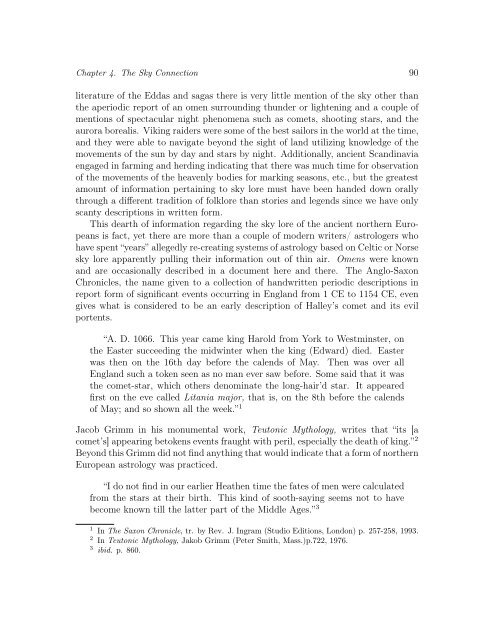Untitled - Awaken Video
Untitled - Awaken Video
Untitled - Awaken Video
You also want an ePaper? Increase the reach of your titles
YUMPU automatically turns print PDFs into web optimized ePapers that Google loves.
Chapter 4. The Sky Connection 90<br />
literature of the Eddas and sagas there is very little mention of the sky other than<br />
the aperiodic report of an omen surrounding thunder or lightening and a couple of<br />
mentions of spectacular night phenomena such as comets, shooting stars, and the<br />
aurora borealis. Viking raiders were some of the best sailors in the world at the time,<br />
and they were able to navigate beyond the sight of land utilizing knowledge of the<br />
movements of the sun by day and stars by night. Additionally, ancient Scandinavia<br />
engaged in farming and herding indicating that there was much time for observation<br />
of the movements of the heavenly bodies for marking seasons, etc., but the greatest<br />
amount of information pertaining to sky lore must have been handed down orally<br />
through a different tradition of folklore than stories and legends since we have only<br />
scanty descriptions in written form.<br />
This dearth of information regarding the sky lore of the ancient northern Europeans<br />
is fact, yet there are more than a couple of modern writers/ astrologers who<br />
have spent “years” allegedly re-creating systems of astrology based on Celtic or Norse<br />
sky lore apparently pulling their information out of thin air. Omens were known<br />
and are occasionally described in a document here and there. The Anglo-Saxon<br />
Chronicles, the name given to a collection of handwritten periodic descriptions in<br />
report form of significant events occurring in England from 1 CE to 1154 CE, even<br />
gives what is considered to be an early description of Halley’s comet and its evil<br />
portents.<br />
“A. D. 1066. This year came king Harold from York to Westminster, on<br />
the Easter succeeding the midwinter when the king (Edward) died. Easter<br />
was then on the 16th day before the calends of May. Then was over all<br />
England such a token seen as no man ever saw before. Some said that it was<br />
the comet-star, which others denominate the long-hair’d star. It appeared<br />
first on the eve called Litania major, that is, on the 8th before the calends<br />
of May; and so shown all the week.” 1<br />
Jacob Grimm in his monumental work, Teutonic Mythology, writes that “its [a<br />
comet’s] appearing betokens events fraught with peril, especially the death of king.” 2<br />
Beyond this Grimm did not find anything that would indicate that a form of northern<br />
European astrology was practiced.<br />
“I do not find in our earlier Heathen time the fates of men were calculated<br />
from the stars at their birth. This kind of sooth-saying seems not to have<br />
become known till the latter part of the Middle Ages.” 3<br />
1 In The Saxon Chronicle, tr. by Rev. J. Ingram (Studio Editions, London) p. 257-258, 1993.<br />
2 In Teutonic Mythology, Jakob Grimm (Peter Smith, Mass.)p.722, 1976.<br />
3 ibid. p. 860.
















